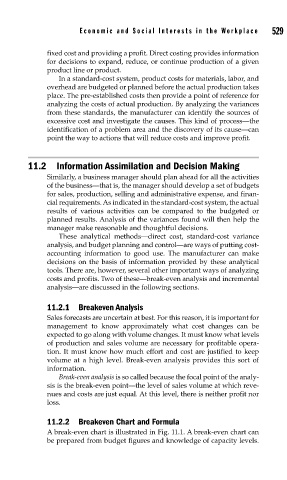Page 576 - Sensors and Control Systems in Manufacturing
P. 576
Economic and Social Inter ests in the Workplace
fixed cost and providing a profit. Direct costing provides information 529
for decisions to expand, reduce, or continue production of a given
product line or product.
In a standard-cost system, product costs for materials, labor, and
overhead are budgeted or planned before the actual production takes
place. The pre-established costs then provide a point of reference for
analyzing the costs of actual production. By analyzing the variances
from these standards, the manufacturer can identify the sources of
excessive cost and investigate the causes. This kind of process—the
identification of a problem area and the discovery of its cause—can
point the way to actions that will reduce costs and improve profit.
11.2 Information Assimilation and Decision Making
Similarly, a business manager should plan ahead for all the activities
of the business—that is, the manager should develop a set of budgets
for sales, production, selling and administrative expense, and finan-
cial requirements. As indicated in the standard-cost system, the actual
results of various activities can be compared to the budgeted or
planned results. Analysis of the variances found will then help the
manager make reasonable and thoughtful decisions.
These analytical methods—direct cost, standard-cost variance
analysis, and budget planning and control—are ways of putting cost-
accounting information to good use. The manufacturer can make
decisions on the basis of information provided by these analytical
tools. There are, however, several other important ways of analyzing
costs and profits. Two of these—break-even analysis and incremental
analysis—are discussed in the following sections.
11.2.1 Breakeven Analysis
Sales forecasts are uncertain at best. For this reason, it is important for
management to know approximately what cost changes can be
expected to go along with volume changes. It must know what levels
of production and sales volume are necessary for profitable opera-
tion. It must know how much effort and cost are justified to keep
volume at a high level. Break-even analysis provides this sort of
information.
Break-even analysis is so called because the focal point of the analy-
sis is the break-even point—the level of sales volume at which reve-
nues and costs are just equal. At this level, there is neither profit nor
loss.
11.2.2 Breakeven Chart and Formula
A break-even chart is illustrated in Fig. 11.1. A break-even chart can
be prepared from budget figures and knowledge of capacity levels.

